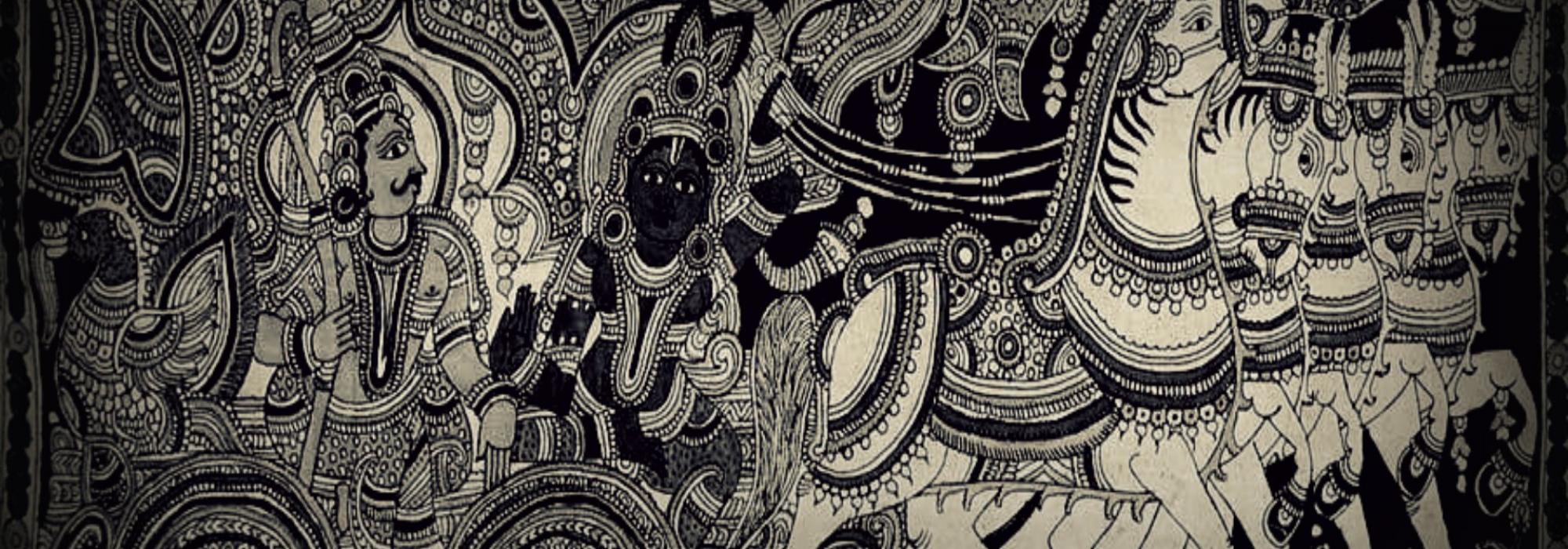New Dimensions of Meaning
The qualities of poetry, song, and sastra are all infused in the Gita. In the view of the Three Acaryas [Adi Sankara, Ramanuja and Madhva], it is evident that the Gita forms the foundation stone for Vedanta-Sastra. However, in the context of the Gita, the term “Sastra” has a deeper connotation than is commonly understood. Here, Sastra means those procedures or processes or methods that come in handy for the pursuit of spirituality.
One may observe a coincidence. In our tradition, there is a certain link between spiritual contemplation and people considered as belonging to the superior Varna. However, Krishna who preached the Gita and Arjuna who listened to it were both Kshatriyas. The ultimate spiritual proclivity of the work becomes clear from this as well.
In the ancient eras, terms like Yoga, Vairagya [renunciation], and Sanyasa had limited meaning. However, the Bhagavad Gita elucidated and established their root meanings in a far expansive sense.
Because the word “Yoga” had popular connotations indicating the regulation of body and mind, the best essence of the Gita’s teaching has been characterized as “Buddhiyoga” [Yoga of the Intellect]. The meaning indicated here is “Awakened Consciousness.”
The explanation of the Gita that the perfect state of Yoga is to transcend the influence of the Trigunas [Sattva, Rajas and Tamas] and remain in a state of egolessness ties in with the Patanjali-Yoga aphorism, “abhyāsayogābhyām tannirodhaḥ.” This means the ways to regulate the mind and intellect are constant practice, a feeling of renunciation, and intense concentration.
Historical Context
The chief teachings of the Gita are timeless. The need to remain ever-active is certainly clear. The notion that the Gita was a spiritual work and established the Vedanta philosophy was pervasive for various reasons. Further, the notion that Vedanta was outside the purview of daily life also contributed to this perception.
However, in reality, it is not possible to separate Vedanta from daily life. Neither does the Vedanta teach that one should remain aloof from worldly life. Vedanta informs us of the attitude that one must have while performing Karma. In fact, the discourse of the Gita originated in order to teach the inevitability of performing Karma. Opposing Adharma and injustice is an inextricable organ of Sanatana Dharma. However, this active spirit became dimmed in the post-Buddhist era because of which both Hindu Dharma and Buddhism weakened. In this manner, the Bharatiya society had become listless for several centuries.
Beginning sometime after the Middle Ages, attempts were made to lift this society from the aforementioned state. This chain of attempts eventually became resplendent and in recent times, the freedom movement became a pretext for the rejuvenation of the innate glory of Hindu Dharma. The chief harbingers of this phenomenon was Swami Dayananda [Saraswati], Vivekananda, Tilak and Aurobindo.
It is unnecessary to elaborate on the relevance and impact of the stirring messages of the Bhagavad Gita, which Sri Krishna preached to Arjuna such as ‘kutastvā kaśmalamidaṃ’, ‘klaibyam mā sma gamaḥ pārtha’, which were used in the freedom struggle against an oppressive alien government.
There exists copious amounts of literature regarding the Bhagavad Gita’s philosophical singularity, its expansiveness, and its spiritual beauty. There’s absolutely no need to newly explain this. However, it is really interesting to recall how the Bhagavad Gita kept increasing its prestige throughout the past few centuries.
Tradition of Commentary
The foremost among the Bhakti Saints of Western India who lived about seven centuries prior was Sant Jnaneshwar Maharaj. His commentary on the Gita, jñāneśvarī is the most poetic, delightful, and contains highly original analogies at every step. It is composed in an ancient idiom which is no longer in usage and is not easy to grasp. Yet, even after seven hundred years, jñāneśvarī still retains pervasive popularity and esteem. This pointedly upholds the fact of the special importance that the Gita discourse enjoys in people’s eyes.
The fact that it were the Muslim kings who commissioned the initial translations of the Bhagavad Gita is also a pointer to its universal nature.
Aurangzeb’s (elder) brother, Dara Shikhoh had become so deeply influenced after reading the Bhagavad Gita that he got it translated into Persian and distributed its copies to his relatives and friends.
Scores of Westerners who have no grounding in Indian culture have also been attracted to Bhagavad Gita – this by itself is another proof of the all-encompassing nature of the work.
In recent history, the foremost to be influenced by the Gita is the first Governor-General of India, Warren Hastings. He was so profoundly impacted by it that he inspired Charles Wilkins to learn Sanskrit and got him to translate the Bhagavad Gita to English. The translation published in 1785 carried an extremely glowing preface that Hastings himself wrote. What he wrote in the preface is interesting:
The work (Gita) will survive when the British dominion in India will have long ceased to exist, and when the sources it once yielded of wealth and power are lost to remembrance.
Hastings also wrote about the Gita with great feeling in letters that he wrote to his friends’ circle. The German scholar Von Humboldt said that
The Bhagavad Gita is the deepest and sublimest production that the world possesses.
gītā sugītā kartavyā kimanyaiḥ śāstravistaraiḥ |
When we have the Gita to guide us in the path of Duty, what is the need for other works of Sastra?
There is an abundance of such laudatory literature on the greatness of the Bhagavad Gita.
To be continued














































